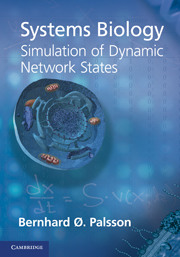Book contents
11 - Coupling pathways
from PART III - METABOLISM
Published online by Cambridge University Press: 05 August 2012
Summary
In Chapter 10 we formulated a MASS model of glycolysis. We took a linear pathway and converted it into an open system with defined inputs and outputs, formed the dynamic mass balances, and then simulated its response to increased rate of energy use. In this chapter, we will show how one can build a dynamic simulation model for two coupled pathways that is based on an integrated stoichiometric scaffold for the two pathways. We start with the pentose pathway and then couple it to the glycolytic model from Chapter 10 to form a simulation model of two pathways to study their simultaneous dynamic responses.
The pentose pathway
The pentose pathway originates from G6P in glycolysis (Figure 11.1). The pathway is typically thought of as being comprised of two parts: the oxidative and the nonoxidative branches.
The oxidative branch G6P undergoes two oxidation steps, including decarboxylation, releasing CO2, leading to the formation of one pentose and two NADPH molecules. These reactions are called the oxidative branch of the pentose pathway. The branch forms two NADPH molecules that are used to form glutathione (GSH) from an oxidized dimeric state, GSSG, by breaking a disulfite bond. GSH and GSSG are present in high concentrations, and thus buffer the NADPH redox charge (recall the discussion of the creatine phosphate buffer in Chapter 8). The pentose formed, R5P, can be used for biosynthesis. We will discuss the connection of R5P with the salvage pathways in Chapter 12.
Information
- Type
- Chapter
- Information
- Systems Biology: Simulation of Dynamic Network States , pp. 204 - 223Publisher: Cambridge University PressPrint publication year: 2011
